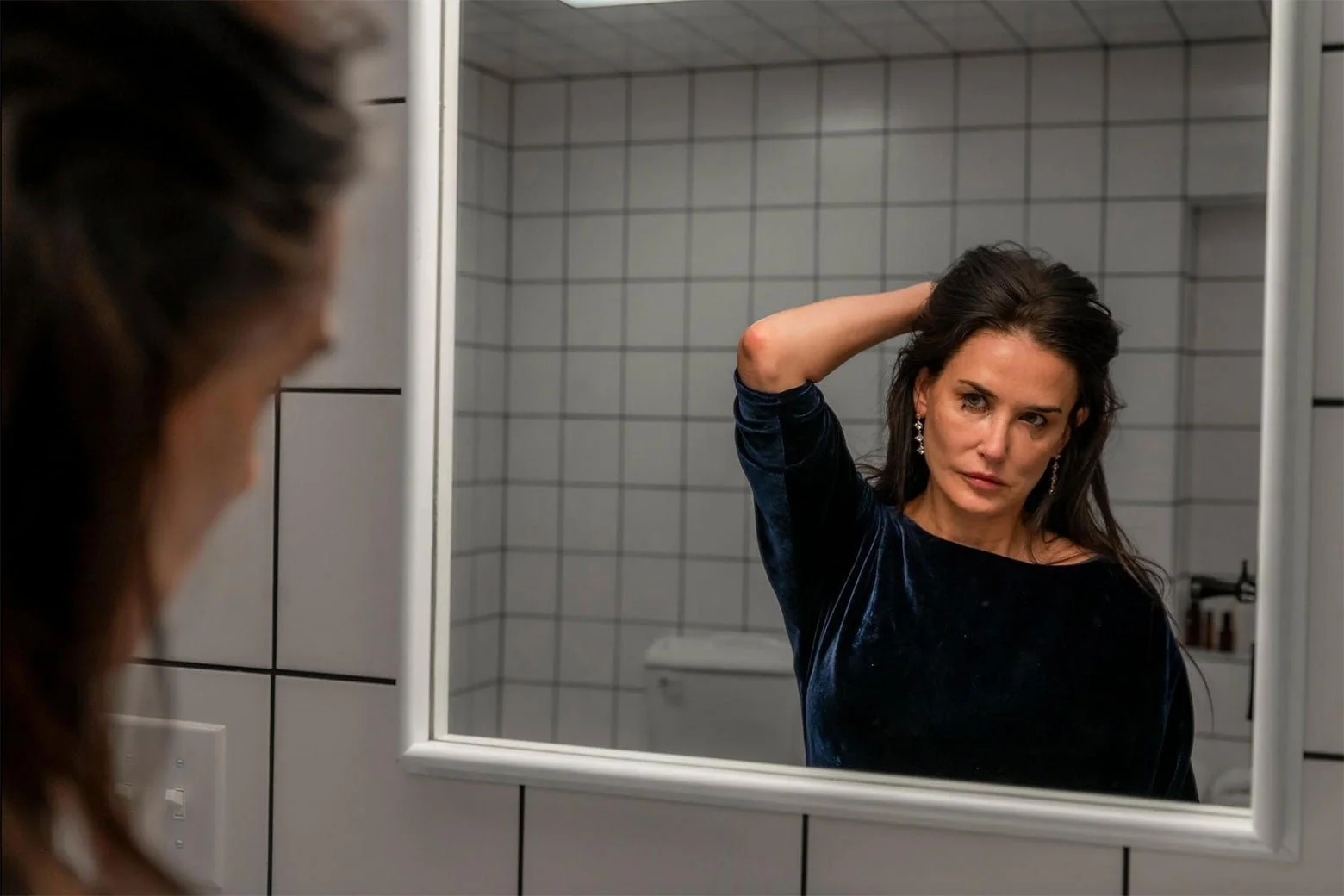THE SUBSTANCE shows a complicated, nuanced look at womanhood
The Substance
Written and Directed by Coralie Fargeat
Starring Margaret Qualley, Demi Moore, Dennis Quaid
Rating R
Runtime 141 minutes
In Theaters Nationwide September 20th
by Tori Potenza, Staff Writer
Last month I had the pleasure of seeing The Substance at FrightFest in London. The neon Barbie Dreamhouse aesthetic that was so memorable in Coralie Fargeat’s feature Revenge (2017) is revived in this body horror celebrity nightmare. While her newest feature has been highly anticipated by many us us genre lovers, its divisive reactions have caused an even bigger stir, especially amongst many women critics. I always love a film that leads to interesting conversations, and that is surely something The Substance will do. My high hopes were not in vain, and I found the movie to be a manic carnival ride of gorgeous filmmaking, memorable performances, and an effective look at women in a patriarchal purgatory.
One of the elements that stood out to me most is Fargeat’s keen cinematic eye. She is an expert at leaning on strong visuals to tell her story. Without any dialogue, she is able to drop audiences into her world and let you know exactly what is going on within the first few minutes. While some filmmakers feel the need to give lengthy exposition, it takes a real craftsman to use the visual medium to its fullest extent and trust the audience to understand what they mean. The camera, set pieces, and performances all help to show the quick descent into madness that Elisabeth Sparkle (Demi Moore) falls into as she fights for the spotlight once again.
One of the many things I love about the horror genre is its inclination to give actresses opportunities when others have decided they’ve aged-out of their usefulness. Moore has given some memorable and fun performances over the last few years with movies like Corporate Animals (2019) and Please Baby Please (2022), and this is another film that shows off her chops. We see an array of emotions as her character grapples with her self image, Hollywood standards, and the terrifying “substance” that was meant to help her. She and Margaret Qualley both show just how powerful, messy, and monstrous they can be as we see their combative relationship evolve.
With such powerful and impressive talent both in front of and behind the screen, it is interesting to see the strong reactionary emotions from the audience. We live in times where social and political views have created a deep crevasse between many people. Making many of us feel raw and like we are in “fight or flight” mode every day. Because of this, I have noticed a tendency for critics and film lovers to question the views, themes, and morals of not only the film but also the filmmaker. Along with Fargeat, Emerald Fennell (Promising Young Woman, Saltburn) is another female filmmaker that falls into the same mix. As we see an increase of diversity in filmmaking, we hold these artists at a higher standard because of their marginalized background, as though they must speak for those they represent. It often comes into question if directors like Fargeat and Fennell are “feminist filmmakers.” One can watch a film like The Substance and have a wide range of reactions, potent emotions, and, by the end, strong opinions in regards to the question of the director’s world views. But ultimately films are art, and they are complicated, collaborative pieces of art.
It is understandable why at such a triggering time we want to put these pieces of art into designated boxes of good/bad or black/white, but the gray area is often where the most interesting art comes from. As people work out their feelings about a wide variety of social issues and the nuances around them, we should remember many things are much more complicated than they appear. While it may be easy to place labels on a film like The Substance as being feminist or not, it is also imperative to remember that art is often a product of its time, and artists working through their own strong emotions may create something that is hard for us individually to parse out or make sense of with our own struggles and world views.
My view is that The Substance is showing us a heightened version of our not too distant future if patriarchal rule still keeps us trapped. Patriarchal society makes women fight against each other instead of finding sisterhood or community. It makes us hate our bodies for not looking like the women on the television. It makes us spend ungodly amounts of money on products to halt the aging process because, especially in show business, women seem to lose their value the older they get. It works in tandem with capitalism to make money off our self-hatred. Fargeat is well aware of the world we are in and the products that vulnerable people who are taught to hate themselves are willing to spend money on. Just by casting someone as gorgeous as Demi Moore and watching her character tear herself apart because she no longer sees that beauty is proof enough. This coupled with the comical fisheye lens close-ups of grotesque men judging these beautiful women only helps to make this point clearer.
Fargeat creates a fascinating world in The Substance. It is beautiful, mean, gross, and bloody. The concept is a lot of fun and harkens back to many body horror favorites from Re-Animator (1985) to The Fly (1986). The biggest issue it has is that the run time is a little decadent, and keeping the story a little tighter would help with the pacing. Otherwise, if you want to see art that is as beautiful as it is disgusting, you will want to check this out.



